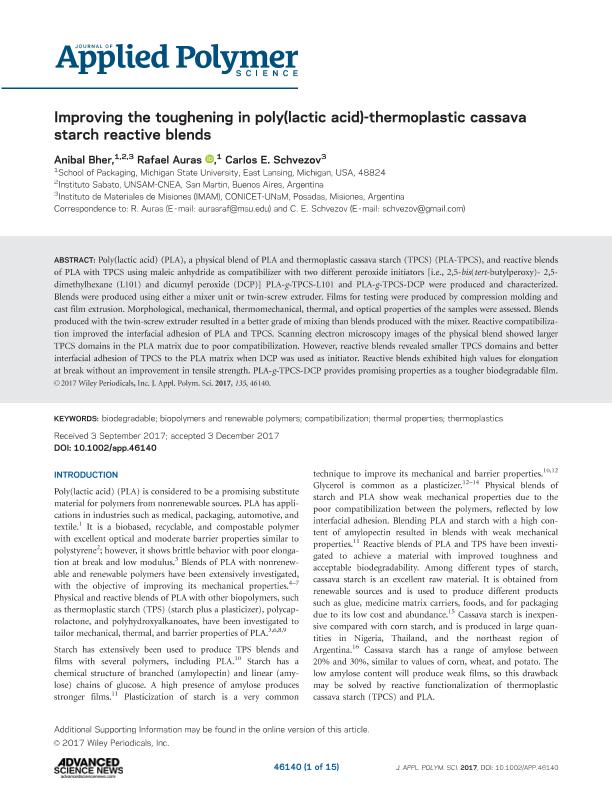Mostrar el registro sencillo del ítem
dc.contributor.author
Bher, Anibal Ricardo

dc.contributor.author
Auras, Rafael

dc.contributor.author
Schvezov, Carlos Enrique

dc.date.available
2019-10-23T18:13:31Z
dc.date.issued
2018-04
dc.identifier.citation
Bher, Anibal Ricardo; Auras, Rafael; Schvezov, Carlos Enrique; Improving the toughening in poly(lactic acid)-thermoplastic cassava starch reactive blends; John Wiley & Sons Inc; Journal of Applied Polymer Science; 135; 15; 4-2018; 1-15
dc.identifier.issn
0021-8995
dc.identifier.uri
http://hdl.handle.net/11336/87110
dc.description.abstract
Poly(lactic acid) (PLA), a physical blend of PLA and thermoplastic cassava starch (TPCS) (PLA-TPCS), and reactive blends of PLA with TPCS using maleic anhydride as compatibilizer with two different peroxide initiators [i.e., 2,5-bis(tert-butylperoxy)-2,5-dimethylhexane (L101) and dicumyl peroxide (DCP)] PLA-g-TPCS-L101 and PLA-g-TPCS-DCP were produced and characterized. Blends were produced using either a mixer unit or twin-screw extruder. Films for testing were produced by compression molding and cast film extrusion. Morphological, mechanical, thermomechanical, thermal, and optical properties of the samples were assessed. Blends produced with the twin-screw extruder resulted in a better grade of mixing than blends produced with the mixer. Reactive compatibilization improved the interfacial adhesion of PLA and TPCS. Scanning electron microscopy images of the physical blend showed larger TPCS domains in the PLA matrix due to poor compatibilization. However, reactive blends revealed smaller TPCS domains and better interfacial adhesion of TPCS to the PLA matrix when DCP was used as initiator. Reactive blends exhibited high values for elongation at break without an improvement in tensile strength. PLA-g-TPCS-DCP provides promising properties as a tougher biodegradable film.
dc.format
application/pdf
dc.language.iso
eng
dc.publisher
John Wiley & Sons Inc

dc.rights
info:eu-repo/semantics/openAccess
dc.rights.uri
https://creativecommons.org/licenses/by-nc-nd/2.5/ar/
dc.subject
BIODEGRADABLE
dc.subject
BIOPOLYMERS AND RENEWABLE POLYMERS
dc.subject
COMPATIBILIZATION
dc.subject
THERMAL PROPERTIES
dc.subject
THERMOPLASTICS
dc.subject.classification
Recubrimientos y Películas

dc.subject.classification
Ingeniería de los Materiales

dc.subject.classification
INGENIERÍAS Y TECNOLOGÍAS

dc.title
Improving the toughening in poly(lactic acid)-thermoplastic cassava starch reactive blends
dc.type
info:eu-repo/semantics/article
dc.type
info:ar-repo/semantics/artículo
dc.type
info:eu-repo/semantics/publishedVersion
dc.date.updated
2019-10-17T14:53:47Z
dc.identifier.eissn
0021-8995
dc.journal.volume
135
dc.journal.number
15
dc.journal.pagination
1-15
dc.journal.pais
Estados Unidos

dc.description.fil
Fil: Bher, Anibal Ricardo. Michigan State University; Estados Unidos. Universidad Nacional de San Martín; Argentina. Consejo Nacional de Investigaciones Científicas y Técnicas. Centro Científico Tecnológico Conicet - Nordeste. Instituto de Materiales de Misiones. Universidad Nacional de Misiones. Facultad de Ciencias Exactas Químicas y Naturales. Instituto de Materiales de Misiones; Argentina
dc.description.fil
Fil: Auras, Rafael. Michigan State University; Estados Unidos
dc.description.fil
Fil: Schvezov, Carlos Enrique. Consejo Nacional de Investigaciones Científicas y Técnicas. Centro Científico Tecnológico Conicet - Nordeste. Instituto de Materiales de Misiones. Universidad Nacional de Misiones. Facultad de Ciencias Exactas Químicas y Naturales. Instituto de Materiales de Misiones; Argentina
dc.journal.title
Journal of Applied Polymer Science

dc.relation.alternativeid
info:eu-repo/semantics/altIdentifier/doi/http://dx.doi.org/10.1002/app.46140
dc.relation.alternativeid
info:eu-repo/semantics/altIdentifier/url/https://onlinelibrary.wiley.com/doi/full/10.1002/app.46140
Archivos asociados
